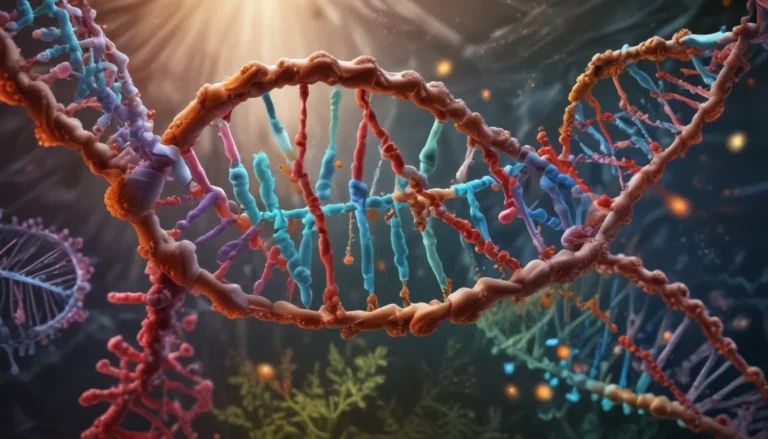A Note About Images: The images used in our articles are for illustration purposes only and may not exactly match the content. They are meant to engage readers, but the text should be relied upon for accurate information.
Evolutionary biology, a captivating branch of science, unravels the intricate processes and patterns of biological evolution, offering profound insights into the history of life on Earth. Scientists have developed a myriad of techniques and tools that have revolutionized our understanding of how species have adapted, diversified, and evolved over millions of years. In this enriching journey, we will explore 12 surprising facts about evolutionary biology techniques that have significantly advanced our knowledge in this field. From the groundbreaking DNA sequencing to the enlightening study of fossils, these techniques have provided us with invaluable revelations about the mechanisms and intricacies of evolution. So, let’s embark on this fascinating expedition and delve into the remarkable methods used by evolutionary biologists to unlock the secrets of life’s evolution.
Unveiling the World of Evolutionary Biology Techniques
Evolutionary biology techniques encompass a diverse array of scientific approaches and methodologies utilized to study and comprehend the processes of evolution. Ranging from genetics and molecular biology to paleontology and ecology, these techniques integrate data from multiple disciplines, offering a comprehensive understanding of how organisms have evolved over time and the factors that have influenced their adaptations.
The Revolutionary Impact of DNA Sequencing in Evolutionary Biology
One of the most pivotal breakthroughs in evolutionary biology was the advent of DNA sequencing technology. This revolutionary technique enables scientists to decode the genetic information stored in an organism’s DNA, providing crucial insights into its evolutionary history. Through advancements in DNA sequencing methods, researchers can analyze the genetic code of various species, compare their genomes, and unveil patterns of genetic variations and mutations that have shaped evolution over millennia.
Illuminating Evolutionary Relationships with Phylogenetic Analysis
Phylogenetic analysis stands as a powerful tool utilized by evolutionary biologists to reconstruct the evolutionary relationships among different species. By scrutinizing the similarities and differences in genetic sequences or physical traits, scientists can construct phylogenetic trees that depict the branching patterns of evolutionary divergence. This profound information not only enlightens us about the evolutionary history of organisms but also offers invaluable insights into the processes steering speciation and adaptation.
Embarking on the Journey of Comparative Genomics
Comparative genomics, a captivating technique, involves comparing the genomes of diverse species to identify evolutionary changes. By examining the similarities and differences in gene sequences, scientists can pinpoint genetic variations that have contributed to the observed phenotypic disparities among species. This technique sheds light on the genetic underpinnings of evolutionary innovations, such as the development of complex traits and adaptations to specific environments.
Journeying Through Time with the Fossil Record
The fossil record serves as a treasure trove of information, unveiling details about past life forms and the historical development of species. Fossils offer direct evidence of extinct organisms and transitional forms, enabling scientists to reconstruct the evolutionary history of life on Earth. By scrutinizing fossils, paleontologists can trace the changes in morphology, behavior, and ecological roles of organisms over time, providing valuable insights into the mechanisms and patterns of evolution.
Unveiling Evolutionary Timelines with Molecular Clock Estimation
Molecular clock estimation serves as a pivotal technique used to determine the timing of evolutionary events based on the rates of genetic mutations. By comparing the disparities in DNA sequences between species and calibrating the mutation rate using known geological or fossil records, scientists can infer the approximate time when two species shared a common ancestor. This method has been pivotal in elucidating the evolutionary timelines of various organism groups and comprehending the tempo at which evolution unfolds.
Observing Evolution in Action with Experimental Evolution
Experimental evolution entails studying the process of evolution in real-time by manipulating laboratory populations of organisms. By subjecting these populations to specific environmental conditions, scientists can observe and analyze the genetic changes that occur over successive generations. These experiments provide valuable insights into the mechanisms of adaptation, natural selection, and the factors contributing to evolutionary change.
Unraveling Genetic Variation with Population Genetics
Population genetics, an intriguing branch of evolutionary biology, focuses on studying the genetic diversity within and between populations. Through the analysis of changes in allele frequencies, scientists can deduce the processes influencing genetic variation, such as genetic drift, gene flow, mutation, and natural selection. Population genetics offers a framework for understanding how populations evolve over time and the factors shaping the observed patterns of genetic diversity.
Demonstrating the Power of Selective Pressures with Artificial Selection
Artificial selection, commonly known as selective breeding, mimics natural selection under human guidance. By selectively breeding individuals with desired traits, humans can create new varieties or breeds within a relatively short timeframe. Artificial selection experiments illustrate the influence of selective pressures in driving evolutionary change, providing insights into the underlying genetic mechanisms.
Unveiling the Evolutionary History of Genes with Molecular Phylogenetics
Molecular phylogenetics, a captivating field, focuses on reconstructing the evolutionary history of genes and their relationships across species. By analyzing genetic sequences, scientists can create phylogenetic trees that illuminate the evolutionary relationships between genes and trace their origins. This technique aids in comprehending how genes have evolved, diversified, and been inherited throughout evolutionary history.
Accelerating Evolutionary Research with Next-Generation Sequencing
Next-generation sequencing (NGS) technologies, such as Illumina sequencing, have transformed evolutionary biology by enabling high-throughput and cost-effective DNA sequencing. NGS techniques empower researchers to generate copious amounts of genetic data from multiple samples, facilitating large-scale evolutionary studies. This advancement has led to profound progress in understanding the genetic foundations of evolution, population dynamics, and the mechanisms steering species diversification.
Shedding Light on Complex Evolutionary Processes with Computational Modeling
Computational modeling plays a pivotal role in evolutionary biology by simulating intricate evolutionary processes that are challenging to study in real-world scenarios. Through mathematical algorithms and simulations, scientists gain insights into the dynamics of evolution, speciation, and the interplay between genetic and environmental factors. Computational models significantly contribute to enhancing our understanding of evolutionary phenomena and fostering the generation of testable hypotheses for further experimental research.
Conclusion
In conclusion, evolutionary biology techniques stand at the forefront of scientific research, unveiling profound insights into the mechanisms driving the evolution of life on Earth. From DNA sequencing to population genetics, these techniques have enabled scientists to scrutinize and comprehend the intricacies of how species have adapted and evolved over millennia.
It is through the utilization of these techniques that we have discerned intriguing facts about the evolutionary history of species, identified genetic variations contributing to adaptation, and traced our ancestral lineage. The continuous advancements in technology and computational biology are poised to further enrich our understanding of the complex processes fueling evolution.
By harnessing the potential of evolutionary biology techniques, scientists are not only unraveling the enigmas of life’s past but also forging a path towards groundbreaking discoveries that will shape the future of scientific exploration and our comprehension of the natural world.
FAQs
- What is evolutionary biology?
-
Evolutionary biology is a scientific discipline dedicated to studying the descent and modification of living organisms across successive generations. It aims to unravel the mechanisms and patterns of biological evolution, including natural selection, genetic variation, and adaptation.
-
Which techniques are commonly employed in evolutionary biology?
-
Some common techniques utilized in evolutionary biology include DNA sequencing, phylogenetic analysis, population genetics, comparative genomics, and experimental evolution. These techniques aid scientists in analyzing genetic data, reconstructing evolutionary relationships, and studying the mechanisms underlying organism adaptation and evolution.
-
How does DNA sequencing contribute to evolutionary biology?
-
DNA sequencing enables scientists to determine the sequence of nucleotides in a DNA molecule, facilitating comparisons of genetic sequences among species, identification of genetic variations, and reconstruction of evolutionary relationships. Analysis of DNA sequences provides insights into genetic changes over time, shedding light on evolutionary processes.
-
What is phylogenetic analysis?
-
Phylogenetic analysis focuses on studying the evolutionary relationships among organisms. By examining shared genetic traits or characteristics, scientists construct phylogenetic trees or cladograms portraying the branching patterns of descent from a common ancestor. This analysis offers a deeper understanding of species relationships and evolutionary divergence.
-
How does experimental evolution contribute to understanding evolution?
-
Experimental evolution involves conducting controlled laboratory experiments to observe evolution in real-time. By subjecting organisms to specific selective pressures, scientists can witness and analyze how they adapt and evolve over successive generations. These experiments provide valuable insights into the mechanisms and dynamics of evolutionary change, validating evolutionary theories and testing hypotheses.
-
How are evolutionary biology techniques relevant to other scientific disciplines?
- Evolutionary biology techniques have broad applications and implications across diverse scientific disciplines such as medicine, conservation biology, agriculture, and biotechnology. These techniques aid in understanding disease evolution, conserving endangered species, enhancing crop yield, and developing novel therapeutics. By delving into the principles of evolution, scientists address pressing global challenges and make significant contributions to human welfare and our understanding of the natural world.
Dive deep into the realm of evolutionary biology and uncover the marvels that shape the ever-evolving story of life. Each technique unveils surprising facts and insights, offering a glimpse into the intricate processes that have driven the diversity of the natural world. Enrich your knowledge and marvel at the wonders of evolution with each revelation. Explore, discover, and embrace the boundless mysteries of life’s evolutionary journey!






